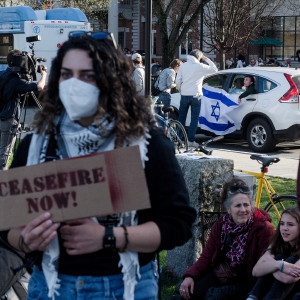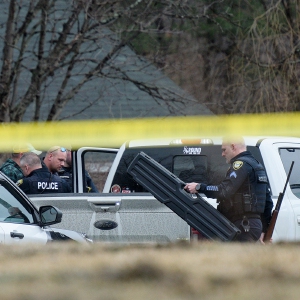2 recent Vermont drug busts have teens — and teen trafficking — at the center of the trade
| Published: 12-07-2023 1:56 AM |
When Barre City police pulled over a gray Ford SUV in September, they said they discovered a 17-year-old boy in the back seat carrying 50 grams of crack, $5,000 and a pistol with its serial number scratched off.
But rather than file charges against the teen, police treated him as a victim. They believe he had been trafficked into Vermont from Springfield, Massachusetts, to sell drugs, with little knowledge of his whereabouts and minimal contact with his family, according to court records.
The case is at least the second this year, following a drug bust in Rutland in June, in which authorities allege adults are using teenagers to ply illegal substances for a profit.
State’s attorneys say the small numbers don’t constitute a trend, but issues of coercion prove challenging to parse and prosecute, especially when the teenagers come from out of state or may be working alongside older family members.
Rutland County State’s Attorney Ian Sullivan, who declined to discuss the specifics of the Rutland case, said he had seen instances of youth in possession of large quantities of drugs, some but not all of which appeared to involve coercion by adults.
“I would be reluctant to draw an overall picture from a relatively small number of cases,” Sullivan said, stopping short of defining any trends regarding justice-involved youth.
But when cases involve juveniles out of state, “those present some pronounced challenges” for Vermont’s courts, he said, because family court often requires in-person participation.
Michelle Donnelly, Washington County state’s attorney, similarly said that while she had seen “some” cases of kids involved in crime — coerced or otherwise — she didn’t think she had enough information to speculate about a pattern.
Article continues after...
Yesterday's Most Read Articles
 Lebanon moves forward with plans for employee housing
Lebanon moves forward with plans for employee housing
 At Dartmouth, hundreds protest ongoing war in Gaza and express support for academic freedom
At Dartmouth, hundreds protest ongoing war in Gaza and express support for academic freedom
 Police break up protest at Dartmouth College, 90 arrested
Police break up protest at Dartmouth College, 90 arrested
 Man tied to Lebanon school lockdowns pleads not guilty to charges
Man tied to Lebanon school lockdowns pleads not guilty to charges
“What’s important to me is that we are doing what we need to do to hold the adults responsible,” she said. When there is a human trafficking component to a drug trafficking investigation, she said, it makes the situation “more serious.”
In court documents, Barre City police identify 33-year-old Bethel resident Gage Garr as a “key component” in the drug trafficking organization using the 17-year-old to sell drugs.
Garr, allegedly the driver of the SUV that was pulled over in September, was charged with cocaine possession and human trafficking almost a month after the traffic stop. A probable cause affidavit filed against Garr details the police investigation into his alleged crimes.
Facing an arrest warrant since October, he was taken into custody on Nov. 26 in Randolph, as he was “released from the scene” following the initial traffic stop, according to court documents.
When he was stopped, he told an officer that the two people in his backseat were “homeless guys from Montpelier,” records show.
Asked to identify themselves, the two passengers turned out to be 16 and 17 years old, respectively.
Barre City police brought the 17-year-old, identified in the police affidavit as “J.V.,” back to the police station, and later connected him to still images of a person suspected of selling drugs.
Amos Gaylord, the Barre City corporal who penned the affidavit, wrote that he contacted the Washington County state’s attorney, who “decided that J.V. in this circumstance is a victim to the subjects who are utilizing him to transport and sell narcotics.”
When Gaylord told the 17-year-old he would not be prosecuted, J.V. told police his story of how he wound up trafficked from Springfield, Massachusetts, to Barre.
According to the teenager, he had gotten involved in the “organization” about a month before the traffic stop. Soon after his initial involvement, a black SUV picked him up along with another person in Springfield.
The driver, a man, “wore a mask the whole time he drove,” J.V. told police.
“J.V. stated that this man brought him to a ‘town that starts with R’ (possibly Rutland) and that they drove through what seemed to be an ‘old fashioned town’ because it had lots of brick,” the affidavit said.
The 17-year-old told police the car drove to the outskirts of town into the woods and up a long driveway, where he met Garr, his alleged trafficker.
Garr brought J.V. to North Barre Manor, a large housing development, according to court documents, where he spent the first week without a cellphone and “just slept.”
The following week, Garr brought J.V. back to the house with the long driveway, and they returned to Barre with drugs in tow, according to the affidavit.
All the while, J.V. said he had no idea where in Vermont he was, and had no clue he was almost three hours from home, police said.
The 17-year-old was then told to sell drugs from North Barre Manor, according to court records.
J.V. received no payment until about two weeks in, when he received $150 and an ounce of marijuana from someone who traveled to Barre from Springfield, Massachusetts, he told police.
Gaylord, the Barre corporal, concluded from his interview with J.V. that “the organization using J.V. gives him limited knowledge about the places he is going, who he is meeting and limits his contact with others including family from back home by not allowing him a cellphone.”
“I believe this is done to make him dependent on those who are using him for the sale of narcotics,” Gaylord wrote.
The corporal also noted that, based on security footage, Garr appeared to drop off a different teenager, a “younger looking” unidentified male at North Barre Manor who appears “much younger” than the other people coming and going with Garr.
When police called J.V.’s mother in Springfield, she said she would come pick up her son, according to a police affidavit.
But she later told police her ride “fell through,” records show.
Adding that she had tried and failed to get an Uber, she then said she would rent a car and call from the highway.
When she didn’t call back, local authorities requested that the Department for Children and Families take custody of J.V., records show. A judge approved a transfer of temporary custody that same day, according to family court documents.
In Rutland, a more than six-month federal investigation uncovered an alleged fentanyl and crack trafficking conspiracy that involved two adults using three kids to sell the drugs.
Federal court documents detail how Rockylane Lewis, of Philadelphia, and Aisha Davy, of Springfield, Massachusetts, allegedly “employed, hired, used, persuaded, induced, enticed, or coerced” the three children into selling fentanyl and crack.
Davy — the mother of two of the kids involved, including a 15-year old and another male juvenile whose age was not included — transported Lewis and “members of his organization” between Springfield, Massachusetts, and Vermont, according to court documents.
In June, Lewis was arrested as part of the extended probe involving federal investigators with the Department of Homeland Security. This fall, Lewis, Davy and another defendant, Holly Howard of Brattleboro, were indicted.
According to court documents, in June, authorities located the 15-year-old involved in Lewis’s drug trade and brought him to the Rutland City Police Department.
A search of the teen’s phone discovered messages between him and Lewis’s Instagram account discussing the price of crack, and sending customers to the 15-year-old to buy the drug.
Sullivan, the Rutland state’s attorney, said that understanding the nuance of how the youth may have been coerced into their criminal actions is “one of the very challenging decision points that go into these prosecutions” when litigating cases involving children.
Sometimes, he said, interviews or phone records explicitly outline how a child was forced into their actions. But not always.
“We might not be getting a picture of the coercive factors at play,” Sullivan said.
But the age of the defendant, he said, would nonetheless factor into a broader consideration of “what a just approach would be.”
Ryan Walsh, public information officer for the Springfield (Mass.) Police Department, said the kids involved in the Rutland raid “are known to the street violence in Springfield,” and he did not consider the kids “trafficked.”
In contrast, Walsh said that J.V., who was involved in the Barre drug bust, “did not have much of a record” in the city.
Asked about how people from western Massachusetts wind up selling drugs in Vermont, Walsh said the trade follows a historical pattern through which cheaper narcotics move north and more accessible guns move south.
While some of this process is led by “street gangs,” he said, the process is not typically “highly organized” and can often involve individuals with some sort of ties to Vermont.
“The drug-addicted community in Vermont often makes its way down into Massachusetts for the heroin,” Walsh said, which is one way people in the two areas build connections that lead to drug trafficking.
But Avaloy Lanning, executive director of the Rutland-based resource nonprofit NewStory Center — which works with survivors of domestic and sexual abuse, as well as human trafficking — vehemently disagreed with Walsh’s assessment.
Lanning did not want to comment specifically on the case, but she said the idea that a 15-year-old working with his mother to sell drugs could be considered an entirely willful participant was “absurd.”
“That sort of sets my hair on fire,” she said. “Their parent or caregiver is the person they look to for guidance, for food … whether that person is parenting responsibly or not, it is still the only parent that person has.”
In her decades of work on human trafficking, Lanning said that labor trafficking — a form of human trafficking in which a person is forced to do work, such as selling drugs — is very rarely prosecuted on the state level.
She said her experience has suggested that sex trafficking, though less common in practice, is more easily identifiable by law enforcement, and is easier to prosecute.
“When it comes to young people and labor, they’re not automatically included or identified as victims of human trafficking,” she said.
Age also factors into trafficking considerations in terms of brain development, according to Lanning, noting that in men, the prefrontal cortex, integral to responsible decision-making, may not fully develop until about 25.
“Certainly they know right from wrong,” Lanning said. “But right from wrong can go out the window when that person who has control over you is asking you to do something.”

 Dartmouth graduate student-workers go on strike
Dartmouth graduate student-workers go on strike
